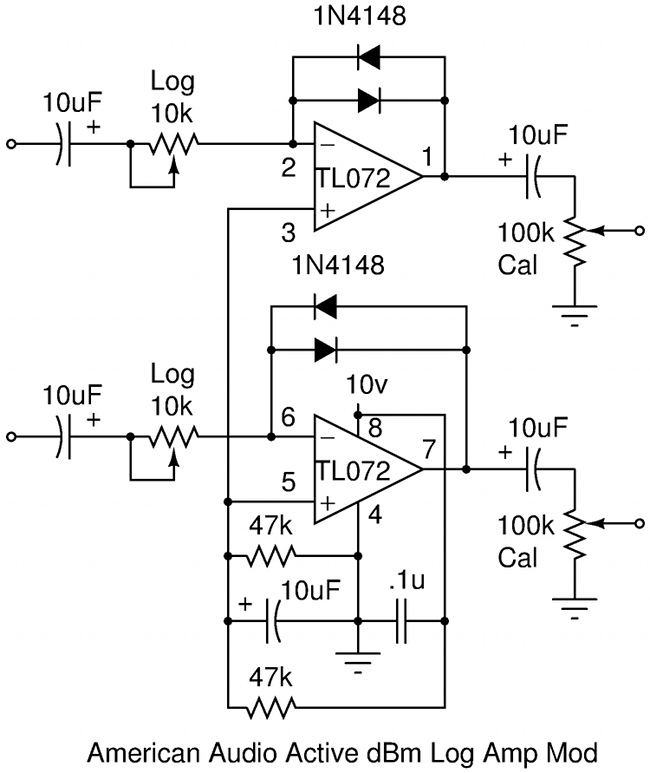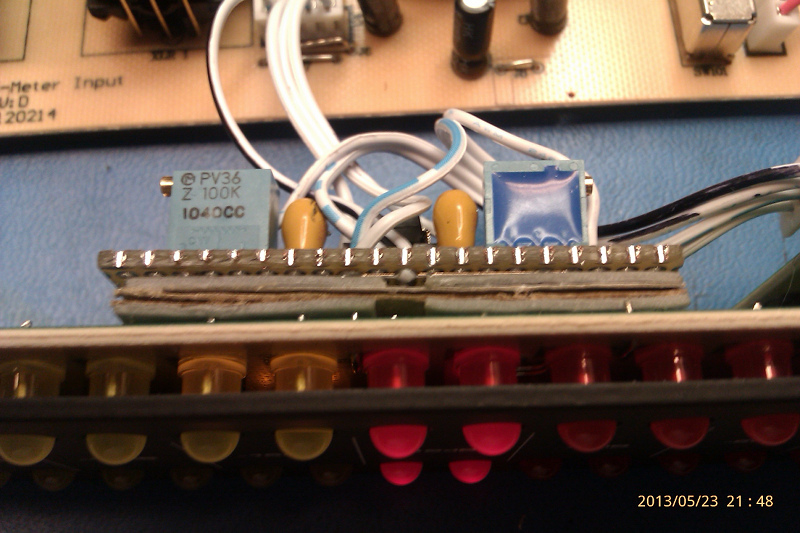

The American Audio Active DBM is a popular, inexpensive (read CHEAP), "VU" meter that costs less than the price of 80 LEDs, four LM3915 chips, a box, and associated pieces to build a stereo level meter. With its "calibrated" front panel showing -57 dB to 0 dB, it would appear to be a really cool piece at a low price. Buyer beware, however...
I have planar magnetic speakers that are quite linear but very power hungry. I often end up pushing my "high freq." (I bi-amp) amplifier close to the onset of clipping in order to get as much out of my system as possible. This led me to pursue the idea of building a peak indicating level meter to monitor the line level feeding my power amplifiers. After sketching and sourcing parts a bit, I discovered the American Audio Active DBM unit. At its under $100 selling price, and (apparently) 57 dB of range, it seemed like a no-brainer of a purchase... So, I bought one.
When I got the unit, I powered it up on the work bench and proceed to attempt setting the front panel calibration pots such that the top "0 dB" LEDs would illuminate just at the onset of clipping for the amplifier in my system. I used a HP 33120A Arbitrary Waveform Generator for this purpose. Over-kill... But, who cares? Once I had carefully set the trimmers, I set the ARB to put out one-half the voltage, fully expecting the Active DBM to display a -6dB level.... (Basic... simple... right?)
The American Audio Active DBM, in stock form, displays -48 dB level for a signal that is 6 dB lower than what it was calibrated for to be 0 dB. In fact, reducing a signal's amplitude by 11 dB is sufficient to move the displayed level from 0 dB, down off of the bottom of the scale at -57 dB.
Initially, I thought perhaps my unit was broken... But, both channels did exactly the same thing. I called the vendor from which I had purchased the unit and queried them. I called the technical support people at American Audio and talked to them. (lolz) Then, I took my unit apart and looked it over, internally. I found some balanced to unbalanced line input amps, a full-wave peak detecting circuit for each channel, feeding into a micro-controller that strobes the display LEDs, multiplexing the lines in a modern fashion. This was a decently executed modern design--just not to the specification I had assumed by looking at the sales material and front panel.
To make a long story short: Nobody seems to be bothered by the fact that the American Audio Active DBM is designed to work exactly as I found mine to. My vendor told me that I was the first customer to ever report that they had checked one of these for calibration accuracy. In a sense, I can understand the collusion of design and marketing here. Most potential customers are looking for blinking, moving lights. And, they can't be bothered with understanding, much less caring, about decibels and such. The stock unit will produce dramatically moving displays of LEDs with a quite modest dynamic range of program material. Such a unit is only accurate at a single level point, of course. I wanted more... I wanted the 57 dB range printed on the front panel, dammit!
I noticed that the display seemed to work in an almost linear fashion.. ( y = mx + b ) A little over a 3 to 1 ratio of signal was required to move the display over the full range, and it was straight forward to calculate the number of millivolts for -57 dB versus a 0 db level.
1 millivolt to 707 millivolts, or 10 millivolts to 7.07 volts, etc.. (57 dB is a BIG change in level, 200 watts RMS versus 0.4 milliwatts RMS)
I realized that this might be a good application for a log-amp. (A log-amp produces an output voltage proportional to the logarithm of the input voltage.) I found a 4 conductor ribbon cable running from the back panel to the front panel, carrying ground, left and right signals, and +10 volts. (very convenient) I decided to design a simple, small board that I could wire into the middle of this ribbon cable--converting the logarithmic changes in level of the input channels into linear changes in the level presented to the front circuit board containing the peak detectors and micro-controller. I cranked the stock calibration trimmers and measured the signal level required to make the display indicate -57 dB and 0 dB. Using LTSpice, I modeled a circuit for a full-wave log amp, using op-amps and garden variety diodes. I knew what levels I needed to come out for a specific level in... I needed to turn an approximately 700 to 1 change in input into an approximately 3 to 1 change in output level, while following an accurately logarithmic function. (plus an offset... the primitive full-wave peak detector circuit used in the unit is insensitive to low level signals.) It turned out to be fairly easy. I used four 20 turn trimmers so I could 'fudge in' the correct amount of gain on both the log and linear sides of the circuit. (This produces an adjustable: Vout = log(base A)(Vin) + B, with A and B adjustable)
This story does, indeed, have a happy ending.

This is a quick sketch of the circuit I ended up using to make the unit correctly display input levels. All of the parts came out of my junk box.




Once this board was installed, I was able to adjust the trimmers such that both channels correctly display the relative level of the input signal at any point from -57 dB to 0 dB... Just like I assumed it should do in the first place. It seems to work better than I had hoped for. Accuracy is better than +/- 1 dB for any step on either channel. I can now consistently push my amplifiers right up to their limits. I am quite happy. Meanwhile, the neighbors are mildly annoyed...
Since installing this into my system, the wide dynamic range of the indicator has caused me to notice things about the program material coming from some of my FM stations that I never noticed before. Background noise from a remote news feed will sometimes show up in the display. The 19 kHz pilot level is clearly visible if I turn things up loud enough and run a tuner without the 'multiplex filter' switched in. It surprised me how far down I could turn the volume, and just how softly the Hi-Fi can play, and still have a visible display on the right-hand side of the display. A level meter with almost 60dB of dynamic range is a useful device, indeed. In my mind, much more useful than one with only 11 dB of range...
In light of the quantity of parts in the stock unit, the cost to add in the necessary parts to make this unit correctly read what the display is labeled for seems negligible. I also find it hard to believe that the technology I used to 'correct' the performance would have been beyond the skill set of the original designer. I can't help but conclude that some designer in China decided, on purpose, to make the American Audio Active DBM perform the way it does in stock form. Whether it was the best choice, in terms of sales and profits, will have to be answered by somebody else. As an experienced design engineer, I wonder...